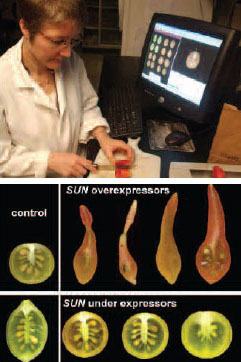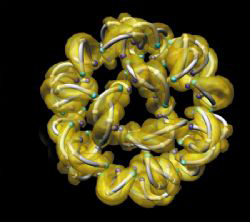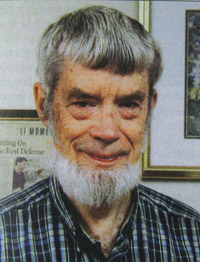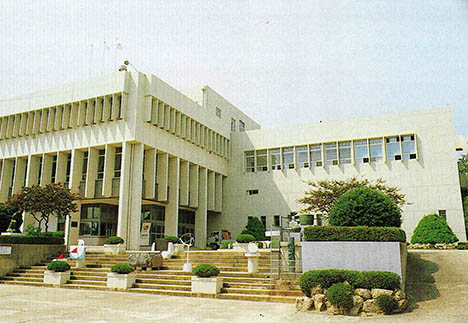
'제임스 듀이 왓슨'은 미국의 위대한 생화학자 중의 한 사람이다. 그는 1953년에 생명의 기본적인 구성물질인 DNA의 이중나선 구조를 밝혀냈다. 이 업적으로 그는 1962년에 노벨 생리·의학상을 받았다. 그리고 현재에는 유전자 연구계획을 이끌도록 선임되었다.
유전자 연구계획이란 무엇인가? 실제, 유전자란 무엇인가?
우선 생명의 무한한 복합적 성격은 모든 세포에서 수천가지의 화학반응이 일어난다는 사실에 연유하는 것이다. 화학반응은 동시에 일어나며 한가지 반응은 다른 반응에 영향을 준다. 두가지 종(種)에서 또는 한가지 종의 두개체에서도 화학반응은 똑같지 않다. 심지어 같은 개체내의 서로 다른 세포에서조차도 다르다. 개체의 특성은 화학반응들의 상호작용에 의해서 결정된다.
각각의 화학반응은 수십 또는 수백의 보다 작은 단위(아미노산)로 구성된 커다란 복합분자인 효소에 의해서 조절되어 지는데, 아미노산에는 사슬로 배열된 20가지 종류가 있다. 만약 한개의 아미노산이 그 자리에서 일탈되거나 다소 변형되면 효소의 작용수행능력은 완전히 변하게 된다.
각개의 효소는 세포의 핵내에 있는 염색체내의 유전인자에 포함된 명령에 따라서 생성된다. 각 유전인자는 기다란 끈 모양의 핵산분자로 구성되어 있는데, 핵산의 구조는 '왓슨'과 그의 공동 연구자인 '프란시스 크릭'에 의해 밝혀졌다. 핵산은 4가지 종류의 "염기"들이 수천개 모여 구성되어 있는데, 이들은 이중나선으로 배열되어 있으며 서로를 미는 침대용수철과 같은 모습을 하고 있다. 4종류의 염기는 이들 이름의 첫머리 글자를 따서 보통 A, C, G 그리고 T로 불리운다.
만약 사람 염색체의 핵산에서 모든 염기의 정확한 순서를 알 수 있다면, 이것을 일련의 문자들로 나타낼 수 있다. 즉 A A C G T G T C …등. 이러한 문자는 '인간 유전자'를 표시하는 것이다. 이 문자들 중에서 한번에 3개를 취한다면, 각각의 "트리플렛"은 특정한 아미노산을 나타내게 된다. 트리플렛의 순서는 효소내의 아미노산 순서를 결정하며 따라서 효소의 구조를 결정한다.
유전자를 알게 된다면, 인간의 구성을 상세하게 이해하기 위한 하나의 거보를 내딛게 되는 것이다. 이것은 다시 우리로 하여금 모든 화학반응을 이해할 수 있게 해 주며, 아마도 이들이 서로 어떻게 영향을 주는지를 알게해 줄 것이다.
이것은 간단한 계획이 아니다. 인간에게는 대략 5만여 종류의 화학반응을 조절하는 5만여 종류의 효소들이 존재한다. 이 효소들의 생성을 좌우하는 정보를 포함하고 있는 핵산분자는 60억개의 염기로 구성되어 있다. 이들 염기를 올바른 순서의 문자로 나타낸다면, 10억개의 단어 또는 대략 브리태니카 백과사전정도의 부피를 가진 책 3백60여 권에 해당할 것이다. 그것은 방대한 정보이기는 하지만, 인간의 신체에 대한 완전한 지식을 얻기 위해서는 이처럼 많은 정보를 필요로 한다.
현재까지도, 염기순서를 천분의 1 정도밖에 정할 수 없지만, 염기순서를 정하는 방법이 빠른 속도로 향상되고 자동화되고 있다. 수십년 후면 인간의 유전자를 완전히 밝혀내게 될는지도 모른다.
그것만으로는 충분하지 않다. 그로 인해 우리는 '표준인간 유전자', 즉 정상적이고 건강한 사람의 유전자를 알게 될 것이다. 그러나 많은 사람들은 한 종류 또는 또다른 종류의 결함있는 유전인자를 갖고 태어나며 그 결과로 선천적이고 유전적인 대사이상(異常)을 가지게 될 수도 있다. 적어도 4천종류의 선천적인 유전인자 결함에 의한 이상이 알려져 있는데, 가능한한 빨리 유전자의 결함을 발견하는 것이 중요하다.
더군다나 정상적이고 건강한 사람들 가운데서도 유전인자는 심각한 이상을 의미하는 것이 아닌 단지 개인적인 차이를 나타내는 다양한 형태로 존재한다. 다양하게 존재하는 유전인자에 의해서 눈과 머리카락의 색깔, 코와 턱, 키와 체격등이 다양하게 나타난다. 모든 사람들이 자신의 고유한 유전자와 핵산'지문'을 할당받을 수 있도록 중요한 변이들을 아는 것은 유용할 것이다.
이것은 반드시 모든 사람들이 개인용 컴퓨터에 3백60권이라는 거대한 분량으로 자신의 완전한 유전자에 대한 정보를 저장해야 함을 의미하는 것은 물론 아니다. 단지 중요한 변이들에 대한 기록을 아는 것을 의미한다.
아마도 언젠가는 과학자들이 현재 생존하고 있는 2백만 종의 식물, 동물, 미생물들의 모든 유전자를 결정하게 될 것이다. 이러한 일을 함으로써 생물들 간의 관계에 대해 보다 더 이해할 수 있으며 생물의 진화과정에 대한 보다 상세한 견해를 갖게 될 것이다. 이론적으로는 우리는 어떤 종도 가지지 못한 새로운 종류의 유전자를 만들어 낼 수도 있을 것이며, 생물학적으로 일어날는지도 모르는 몇몇 일을 알수도 있을 것이다. 이것이 바로 '왓슨'박사가 현재 진행하고 있는 실로 방대한 연구계획이다.
James Deway Watson is one of America's greatest biochemists. He helped worked out the structure of the double helix of DNA, the basic component of life, in 1953. For this he received a share of the Nebel Prize for physiology and medicine in 1962. And now, he has been chosen to head the genome project.
What is the genome project? In fact, what is the genome?
To begin with, the infinite complexity of life rests on the fact that in every cell there are many thousands of chemical reactions, all taking place simultaneously, and each affecting all the others. In no two species or, for that matter, two individuals of the same species, is the chemistry precisely alike. It is even different in different cells of the same individual. The nature of each organism is determined by the interlocking chemical reactions.
Each chemical reactions is controlled by a different enzyme molecule, a large complex molecule composed of dozens or hundreds of smaller units ("amino acids"), of which there are 20 kinds, arranged in a chain. If a single amino acid is out of place, or is slightly modified in place, a particular enzymes capacity to do its work could be completely altered.
Each enzyme is produced according to the directions contained in the genes within the chromosomes that are located in the nucleus of the cell. Each gene consists of a long string of nucleic acid molecules, the structures of which were determined by Watson and his co-worker, Francis Crick. The nucleic acid consists of thousands of units called "nucleotides", of four different varieties, all arranged in a double helix, which looks like two bedspring pushed together. The four different nucleotides are usually known by the initial letters of their names : A, C, G and T.
If we could determine the exact order of all the nucleotides in the nucleic acids of the human chromosomes, we would have a series of letters : AACGTGTCGAA… and so on, that would make up the "human genome". If we take these letters three at a time, each "triplet" represents a particular amino acid. The order of the triplets determines the order of the amino acids in the enzymes and therefore the enzymes structure.
Knowing the genome, we would take a giant step toward grasping scheme of the human being in detail. This, in turn, would enable us to understand all the chemical reactions and, perhaps, how they affect each other.
It's not a simple project. In the human being, there are perhaps 50,000 enzymes controlling 50,000 chemical reactions. The nucleic acid molecules that contain the information that leads to the formation of these enzymes are made up of 6billion nucleotides. If these nucleotides are represented by letters in the right order, that would represent a billion words, or, roughly, the equivalent of 360 books, each the size of a volume of the Encyclopaedia Britannica. That's a lot of information, but, then, a complete knowledge of the human body requires a lot of information.
Even today, only about a thousandth of the nucleotides have been placed in order but the methods for determining the order of the nucleotides are rapidly being improved and automated. It may be that in a few decades, the human genome will be worked out.
Even that will not be enough. It will give us the "standard human genome"; one that will be found in a normal, healthy human being. However, many people are born with defective genes of one kind or another and may have serious inborn and inheritable metabolic abnormalities as a result. There are at least 4,000 identified such abnormalities known to be encoded in the genome at birth, and it is important that we have methods for the detection of these abnormalities in the genome as early in life as possible.
What's more, even among normal, healthy human beings, genes exist in varieties that may not imply serious abnormalities but that still introduce individual differences. Genes, in different varieties, lend different colors to the eyes and hair, different shapes to noses and chins, different appearances in height and structure. It would be useful to identify the important varieties so that every individual can be assigned his own genome and his own nucleic acid "fingerprint".
This will not necessarily mean that every person will have to carry his entire genome in 360 giant volumes in his personal computer, of course - merely a record of the major variations.
Eventually, perhaps, scientists will determine the genomes for every one of the 2 million species of plants, animals, and microscopic organisms now alive. That might give us a keener understanding of relationships among living things and a more detailed look at the course of biological evolution.
We might even work out, in theory, new kinds of genomes that no species possesses, and learn some of the might-have-beens of biology. It is indeed and enormous project that Dr. Watson is now undertaking.
(c) Los Angeles Times Syndicate

















